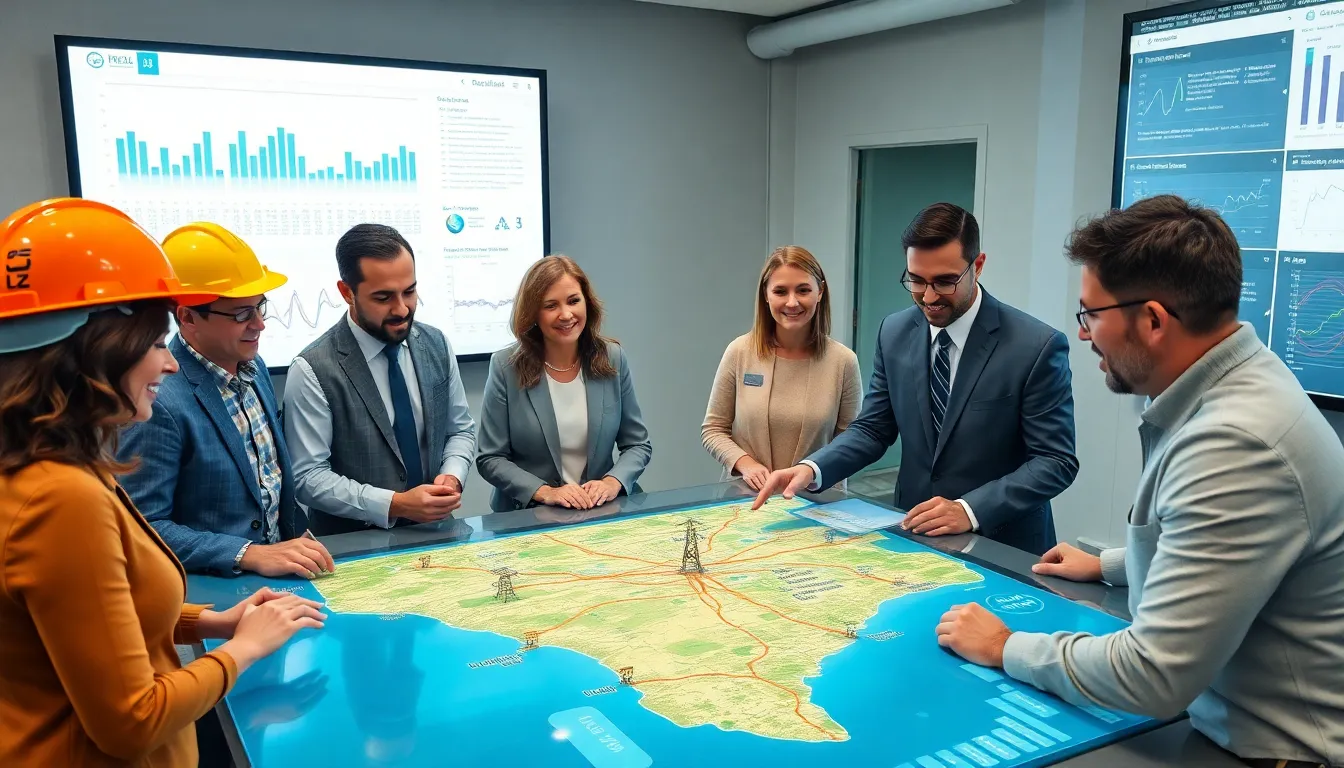In today’s world, critical infrastructure protection isn’t just a buzzword; it’s a necessity. Imagine a day without power, clean water, or even the internet—chaos would reign! From transportation systems to energy grids, these essential services keep society running smoothly and safely. But what happens when they’re under threat?
As cyberattacks and natural disasters become more frequent, safeguarding these lifelines has never been more crucial. It’s like trying to defend your last slice of pizza at a party—everyone wants a piece, and you’ve got to be vigilant! This article dives into the importance of protecting critical infrastructure, exploring strategies that can help keep our communities safe and sound. Buckle up; it’s time to take a closer look at how we can fortify our defenses and ensure that our modern world remains intact and thriving.
Table of Contents
ToggleOverview of Critical Infrastructure Protection
Critical infrastructure protection encompasses safeguarding systems that provide essential services, such as power generation, transportation, and healthcare. These services rely on interconnected networks, and disruptions can lead to severe consequences for public safety and economic stability. Protecting these assets from various threats, including cyberattacks and natural disasters, remains a top priority for governments and organizations.
Growing reliance on technology enhances the need for robust security measures. Many critical systems face a constant barrage of potential attacks from malicious actors aiming to exploit vulnerabilities. In response, organizations implement comprehensive risk management strategies and prioritize resilience in their infrastructure.
Collaboration plays a vital role in effective protection. Public-private partnerships strengthen security by leveraging resources and expertise from various sectors. Engaging stakeholders in planning and response initiatives fosters a shared responsibility for safeguarding critical systems.
Investment in technology also ensures protection. Solutions like advanced threat detection systems and real-time monitoring enhance responses to incidents. Trained personnel remain essential, as skilled workers assess risks and implement protective measures.
Finally, regular training and exercises build preparedness for potential disruptions. By simulating emergencies, organizations can identify weaknesses and refine response plans. Sustained focus on critical infrastructure protection contributes to a stable and thriving society.
Importance of Critical Infrastructure

Critical infrastructure plays a vital role in the smooth operation of society. Protecting these systems ensures the delivery of essential services.
Economic Impact
Economic stability relies heavily on critical infrastructure. Disruptions to power supply, transportation, or communications can lead to significant financial losses. For instance, cyberattacks on financial institutions can halt transactions and paralyze operations, costing millions. Furthermore, recovery from such events often requires extensive resources and time, affecting local economies and job markets. The importance of safeguarding these systems becomes evident when considering the ripple effects on businesses. Strong infrastructure protects against economic downturns and fosters growth, making it imperative to invest in security measures.
Social Stability
Social stability hinges on reliable access to critical infrastructure. Citizens depend on uninterrupted services such as water, healthcare, and emergency response. A failure in these systems can lead to panic and decrease public trust in governing bodies. Medical facilities rely on continuous power for patient care, while clean water access is crucial for community health. Moreover, transportation disruptions can hinder emergency services, putting lives at risk. Ensuring the protection of infrastructure fosters community resilience. Enhancing security measures promotes trust and stability, reinforcing the fabric of society.
Threats to Critical Infrastructure
Threats to critical infrastructure encompass various aspects that jeopardize essential services. These risks can stem from both cybersecurity measures and physical confrontations.
Cybersecurity Risks
Cybersecurity risks rank among the most pressing threats to critical infrastructure. Hackers can exploit vulnerabilities within systems, causing widespread disruptions. Attacks like ransomware can incapacitate operations in sectors such as healthcare and transportation. In 2021, cyberattacks on critical infrastructure increased by over 35 percent compared to previous years. It’s vital for organizations to employ robust security protocols and conduct regular assessments to counteract these threats effectively. Real-time monitoring and advanced threat detection systems serve as essential tools for identifying and neutralizing potential risks before they escalate.
Physical Threats
Physical threats also pose significant challenges to critical infrastructure. These hazards include acts of terrorism, vandalism, and natural disasters. Security breaches can disrupt service delivery, leading to public panic and economic setbacks. In 2020, the U.S. experienced more than 300 incidents impacting critical infrastructure from physical attacks. Infrastructure can become vulnerable due to inadequate security measures or insufficient resources for protection. Therefore, strengthening access control, surveillance, and emergency response protocols can significantly mitigate the impact of physical threats. Developing comprehensive security plans helps ensure stability in public services and infrastructure resilience.
Strategies for Effective Protection
Protecting critical infrastructure involves multi-faceted strategies that address risks effectively. Prioritizing comprehensive approaches helps maintain stability and security across essential services.
Risk Assessment
Conducting regular risk assessments is vital for identifying potential vulnerabilities within critical infrastructure. Such assessments should analyze various threats, including cyberattacks and physical disruptions. Techniques for prioritizing risks can include utilizing threat intelligence and evaluating the impact of potential failures on services. Organizations gain insights by employing quantitative methods, such as risk matrices, to evaluate their infrastructure’s resilience. Developing a response framework based on assessment findings enables stakeholders to allocate resources where they are most needed.
Implementation of Best Practices
Implementing best practices enhances the security of critical infrastructure. Security protocols, such as encryption and access controls, minimize exposure to cyber threats. Regular updates to software and hardware strengthen defenses against emerging vulnerabilities. Training employees on security awareness establishes a culture focused on protection. Collaboration through information sharing among stakeholders encourages adaptation to evolving threats. Establishing incident response plans lays the groundwork for effective recovery in the event of a disruption. Prioritizing these best practices ensures robust security and sustainable operations across key infrastructure sectors.
Role of Government and Policy Makers
Government entities and policymakers play crucial roles in critical infrastructure protection. They establish regulations that dictate security standards for essential services. Adopting comprehensive strategies ensures public safety and economic stability.
Funding for security initiatives remains a priority. Allocating budgets to advanced technology and system upgrades bolsters defenses against potential threats. Legislators work alongside industry experts to develop frameworks that address emerging risks, such as cybersecurity and natural disasters.
Protocols for collaboration between public and private sectors are vital. Establishing partnerships allows for resource sharing and talent pooling. Engagement with various stakeholders, such as utility companies and healthcare providers, enhances understanding of specific vulnerabilities.
Training programs for both government personnel and private sector employees reinforce preparedness. Regular drills and exercises improve response capabilities to potential disruptions. Incentives for organizations that demonstrate exceptional security measures can further promote resilience across critical infrastructure.
Research and innovation serve as foundational elements. Investing in new technologies, like real-time monitoring systems, provides enhanced threat detection. Their data-driven approaches allow for timely interventions that mitigate risks effectively.
Lastly, ongoing assessments of policies are essential. Reviewing effectiveness ensures that strategies adapt to evolving threats. The focus on robust protective measures cultivates a culture of safety that benefits communities nationwide.
Protecting critical infrastructure is vital for ensuring the stability and safety of society. As threats evolve and become more sophisticated, a proactive approach to security is essential. By fostering collaboration between public and private sectors and investing in advanced technologies, communities can build resilience against potential disruptions.
Ongoing training and regular assessments will help organizations stay prepared for emerging risks. A commitment to safeguarding these essential services not only protects economic stability but also reinforces public trust. Prioritizing critical infrastructure protection is a necessary step toward a secure and thriving future for all.




